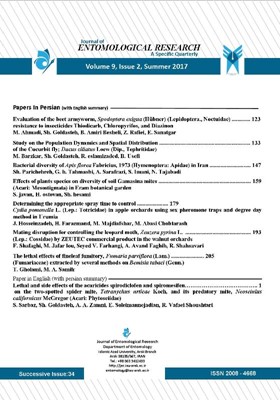Bacterial diversity of Apis florea F. (Hym., Apidae) in Iran
Subject Areas : entomology and othea arthropodsSh. Parichehreh 1 , G. H. Tahmasbi 2 * , A. Sarafrazi 3 , S. Imani 4 , N. Tajabadi 5
1 - Department of Agricultural Entomology, Science and Research Branch, Islamic Azad University, Tehran, Iran
2 - Honey bee Department, Animal Science Research Institute of Iran, Agricultural Research, Edcucation and Extention Organization (AREEO), Karaj, Iran
3 - Department of Insect Taxonomy Research, Institute of Plant Protection, Agricultural Research, Edcucation and Extention Organization (AREEO), Tehran, Iran
4 - Department of Agricultural Entomology, Science and Research Branch, Islamic Azad University, Tehran, Iran
5 - Department of honeybee, Animal Science Research Institute of Iran, Agricultural Research, Edcucation and Extention Organization (AREEO), Karaj, Iran
Keywords:
Abstract :
Apis florea F. and Apis mellifera L. are two honey bee species in Iran. Distribution of Apis florea starts from Paveh in Kermanshah province (located in west of Iran) and ends to Sistan-Baluchestan province (located in south east of Iran). The current study was carried out by collecting 1400 worker bees from 14 different colonies located in southern regions of Iran. The samples were kept in sterile test tubes containing normal saline. The specific media were used to isolate Lactobacillus bacteria from digestive tracts of the bees. Biochemical tests and DNA extraction were done to identify the colonies. In addition, the colonies were characterized by sequencing 16S rRNA gene using specific primers (27F and 1492R). Since bacterial diversity in digestive tracts is of the approaches for classifying insects from phylogenetic point stand, sequencing was done on 43 colonies of bacteria. The results showed that eight isolates were related to three species (Lactobacillus kunkeei, Lactobacillus plantarum and Lactobacillus apis). Basis on the results, the dwarf honey bee in Iran phylogenetically clustered in five distinct clades in terms of bacterial diversity in digestive tracts. The clades were: 1): Roudan, Bandar-Abbas, Iranshahr 2) Jiroft, Kahnuj, Bushehr, Ahwaz, Dehloran 3) Gachsaran 4) Jahrom, Fasa, Behbahan and 5) Qeshm population. Furthermore, the results indicated that Lactic acid bacterias found in digestive tracts depends on nectar and pollen feeding by this wasp in the geographically different localities.
_||_

